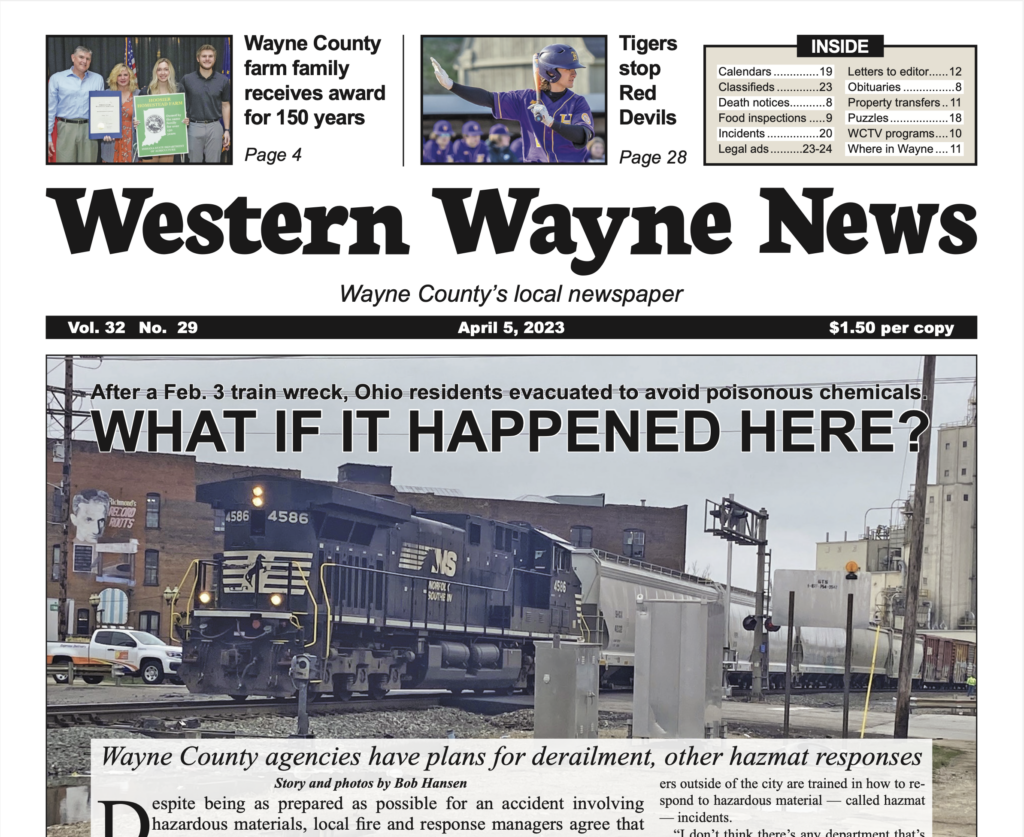As soon as word spread that the massive plume of black smoke billowing over Richmond on Tuesday, April 11, was from burning plastics, many began to wonder about the health impacts on the community’s air, water and soil.

Top of mind might have been the February train derailment just 300 miles away in East Palestine, Ohio, where the unexpected burning of hazardous chemicals prompted an evacuation, short-term health problems and concerns about whether exposure would cause cancer or other long-term health problems in residents.
Just two hours after the fire started, representatives from the Environmental Protection Agency, Indiana Department of Environmental Management and another team experienced with handling hazardous materials were on their way to the site to assess the danger.
When they arrived, they took a sample from the fire area itself and began continuous testing of the air at various points around Richmond, using both stationary equipment and coordinators moving around town with mobile measuring sensors.
The day after the fire, a group from Indiana University arrived with additional equipment to supplement those efforts, allowing for testing in an expanded area that included Darke and Preble counties.
What were they looking for? Particulates, carbon monoxide, volatile organic compounds, benzene, chlorine, hydrogen cyanide, mineral acids and other chemicals that might be expected to show up in a plastics fire.
Like many materials used in modern manufacturing and chemical production, some of these can be safe when handled properly but deadly when exposure is unintentional or prolonged. Benzene, for instance, is classified as a carcinogen where no amount of exposure is considered safe for humans because of how rapidly it is metabolized; long-term exposure through the air or contaminated water can cause leukemia, a fatal cancer, and other diseases.
The day the fire started, Matthew Cain, director of Wayne County Emergency Communications and Wayne County Emergency Management, told Western Wayne News that his agency initially believed there would be no impact on or danger to the quality of Richmond’s drinking water supply, but could not offer any determination about the effects of the fire on surface water runoff or on air quality.
Firefighters on the scene worked to prevent chemical exposure for themselves and the surrounding community from the beginning. Richmond Fire Department Chief Tim Brown told WWN that procedure dictated the wearing of personal protective equipment for all first responders at the scene, limiting dangers posed by chemicals in the air.
They also worked with the city’s sanitation department to direct the runoff water from firefighting efforts to dedicated routes that would allow for special treatment before being reintroduced into the water supply.
IDEM representatives on April 12 placed booms and hay on the East Fork of the Whitewater River to prevent particulates and debris from flowing down the river. Their testing that day and the next day did not show any contamination from water runoff at the fire scene, and their monitoring of waterways several miles to the south did not observe any fish kills or other environmental impacts.
Jason Sewell with the EPA said the same day that a sample of debris located outside of the fire zone tested positive for asbestos, a material known to cause cancer and other diseases after prolonged exposure. Sewell said anyone finding debris should leave it alone and seek guidance from authorities by calling (765) 973-9300, adding the worst thing someone could do is mow over the debris and break it up.

Federal contractors were brought in later in the week to begin collecting, testing and safely disposing of debris from the fire being found throughout the area. According to a post from city officials on Saturday, EPA workers are “searching for, flagging, and removing debris from the fire. Out of an abundance of caution, these asbestos professionals will wear protective gear as they wet and gather materials until sample results are returned, determining the level of protection necessary. As the potential for worker exposure to asbestos is minimized, protective gear will be downgraded.”
But as night fell on the fire scene Wednesday, Richmond residents who might have expected a more definitive understanding of whether they were safe and when life could start to return to normal were left wanting.
Officials said that more testing was needed and asked for patience, as well as emphasizing that observing the emergency orders to stay away from the scene and avoid breathing air that might be coming from the fire was still very important.
By Friday, April 14, the agencies had conducted over 1,100 tests at more than 50 locations, both stationary and roving, according to Sewell. But even with all of that data and despite growing resident frustration and uncertainty, there was not enough information to make a determination on lifting the orders to evacuate or shelter in place.
Having detected both hydrogen cyanide and benzene in one location at the fire scene, receiving reports of headaches, vomiting and sore throats by those wandering around the area, and knowing that there were still lab tests and other results pending, officials said they believed they needed to err on the side of protecting public health. They reiterated that residents need to “stay out” of the evacuation area and that there may still be particulate matter in the air that could cause respiratory distress.

Officials were to meet Saturday to reassess. But even when those orders are lifted, the concern for chemical exposure and other health hazards will be ongoing.
Brown says that the fire department has processes in place to monitor first responders for any signs of health issues resulting from their work, including daily health checks when the scene is active, periodic evaluations and yearly physicals.
Agency leaders are careful to note that they will not be able to provide individual health assessments or predict future concerns, and will mostly be limited to using data collection results to indicate what general kinds of risks might have been present across the community during the fire response.
Mayor Dave Snow said Friday that EPA has requested space to set up a headquarters in Richmond so its staff can actively monitor and guide the environmental response, and that they’ll be a part of the effort to coordinate cleanup with local school systems, parks and others.
Christine Stinson, Wayne County Health Department executive director, said Friday that while she doesn’t want to frighten anyone and an increase in fire-related illness hasn’t yet been seen, “We have to be realistic, this was a plastics fire.”
Updated to correct a date reference for Friday, April 14.
A version of this article appeared in the April 19 2023 print edition of the Western Wayne News.

